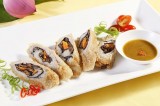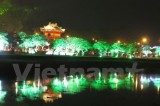Toshiki Ando, director of the Japan Foundation Center for Cultural Exchange in Vietnam, said he had noticed a recent increase in the number of Vietnamese restaurants springing up in major Japanese cities, while local television channels were also airing more programs on Vietnamese cuisine.
The opposite case could also be observed in Vietnam, Ando said, with as many as 200 Japanese restaurants in Ho Chi Minh City alone, and an additional 300 restaurants offering Japanese food on the menu, the director said.
Kazuo Nishiyama, head chef of a Japanese restaurant at a five-star hotel in Ho Chi Minh City, who has been living in Vietnam for 18 years, was surprised the first time he tried Japanese food in Vietnam, as it tasted nothing like that prepared in his home country.
Things are different now, the chef said, as Japanese dishes served in Vietnam are getting closer and closer to their original flavor.
“I think it is because the skills of Vietnamese chefs have been improved,” Nishiyama said.
Toshiki attributed this improvement to the openness between the two governments and peoples who are equally willing and eager to learn about the other’s culture.
According experts at the seminar, Vietnam and Japan both boast long coastlines that run the length of the countries, making seafood and vegetables top choices on the daily menu of Vietnamese families.
Both Vietnamese and Japanese cuisines emphasize the freshness and natural flavors of the ingredients without excessive seasoning, according to Dr. Nguyen Nha, who is running a local project aimed at promoting Vietnamese cuisine to international diners.
Nha added that prominent methods of cooking in both countries are steaming and boiling, which are best for preserving the original flavors of ingredients compared to other methods. He added that dishes prepared with fresh and raw seafood are common in both countries.
 |
| Toshiki Ando, director of the Japan Foundation Center for Cultural Exchange in Vietnam, speaks at the seminar on Vietnam-Japan cuisines in Ho Chi Minh City, January 14, 2017. |
Kajiwara also noted a difference in the use of seasonings, as Vietnamese people prefer fish sauce while their Japanese friends use soya sauce in adding saltiness to the dish.
“Understanding these key similarities and differences has facilitated our export of Vietnamese rice to other countries as well as our sales of Japanese products in Vietnam,” the CEO explained.
Bui Ta Hoang Vu, director of the Ho Chi Minh City Department of Tourism, underscored the importance of local cuisine in improving the appeal of the city’s tourism industry.
In 2016, the city welcomed more than five million foreign visitors, over 500,000 of which were from Japan, making the East Asian country the fourth largest market for Ho Chi Minh City’s tourism, Vu said.














